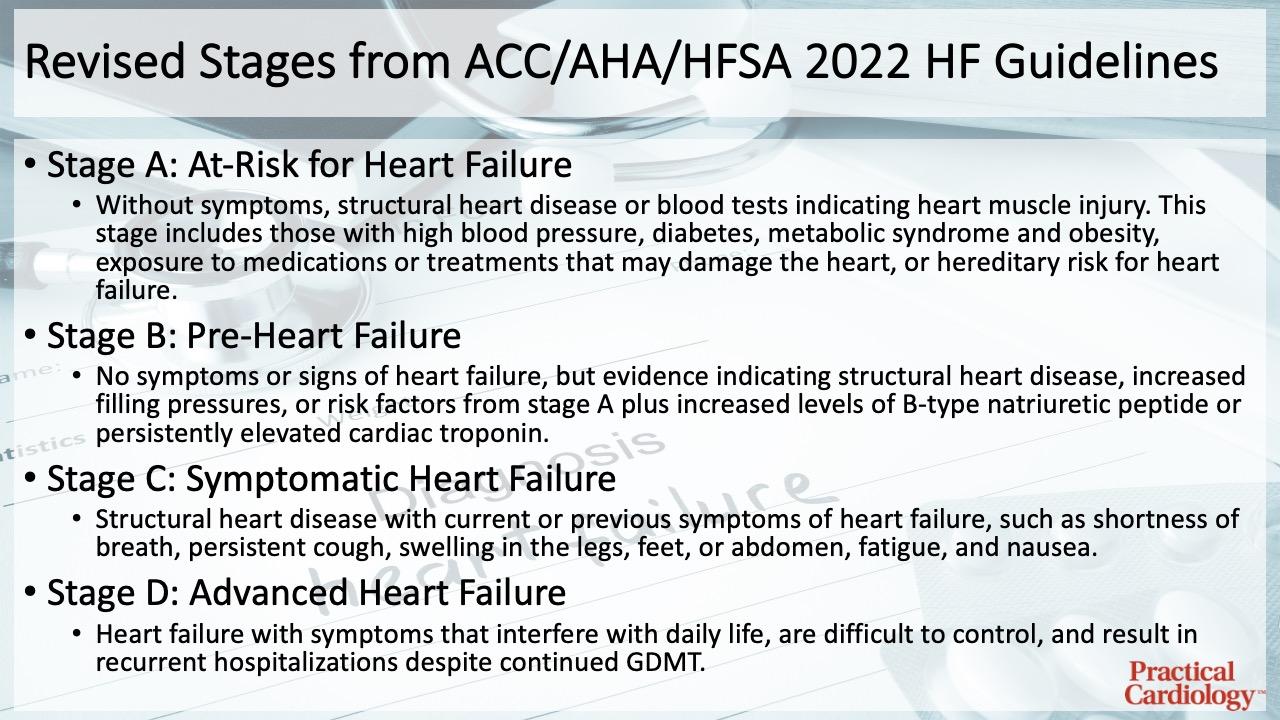ACC, AHA, and HFSA Partner to Release 2022 Heart Failure Guidelines
Released on the eve of ACC.22, the 2022 heart failure guidelines represent a collaborative effort by the ACC/AHA/HFSA and include major additions, including a new focus on the use of SGLT2 inhibitors and revisions to the ACC/AHA stages of heart failure.
The American College of Cardiology, American Heart Association, and Heart Failure Society of America have released a new joint guideline outlining evidence-based strategies for prevention, diagnosis, and management of heart failure.
Published with the intent of replacing previous guidance published in 2013 and 2017, the guideline includes multiple new additions, including a class 2a recommendation for use of SGLT2 inhibitors in HFpEF and revision to ACC/AHA heart failure stages, and also provides recommendations on managing cardiac amyloidosis and cardio-oncology complications.
“One primary goal with the new guideline was to use recently published data to update our recommendations for the evaluation and management of heart failure,” said Paul A. Heidenreich, MD, MS, guideline writing committee chair, in a statement from the American College of Cardiology. “One focus was prevention of heart failure through optimizing blood pressure control and adherence to a healthy lifestyle.”
Published on April 1, which is just a day prior to the start of the American College of Cardiology’s 71st annual Scientific Session (ACC.22), the 159-page document broken down into 14 sections with multiple subsections and cites more than 700 reference documents. Composed by Heidenreich and a team of more than 50 fellow authors, the guideline is based on an evidence review of relevant studies and data published through September 2021.
A major highlight of the new guidelines is the revision of ACC/AHA stages of heart failure, which was aimed at earlier identification of heart failure risk factors and provide treatment options to encourage earlier interventions.
Revised Heart Failure Stages from the ACC/AHA.

“In recent years, there has been an increase in rigorous science assessing how best to treat symptomatic heart failure. With this new guideline, the writing committee hopes to inform better treatment options for a broader number of our patients with heart failure,” Heidenreich said.
Featured immediately following the table of contents in the early portions of the document is a group of 10 top take-home messages selected by the guideline’s writing committee.
- GDMT for HFrEF includes 4 medication classes that now includes SGLT2 inhibitors.
- SGLT2 inhibitors carry a Class 2a recommendation in HFmrEF and Class 2b recommendations are made for ARNIs, ACE inhibitors, ARBs, MRAs, and beta-blockers.
- In HFpEF, SGLT2 inhibitors carry a Class 2a recommendation, MRAs carry a Class 2b recommendation, and ARNIs carry a Class 2b recommendation. Recommendations have also been renewed for treatment of hypertension (Class 1), treatment of AF (Class 2a), use of ARBs (Class 2b), and avoidance of routine use of nitrates or PDE 5 inhibitors (Class 3).
- Improved LVEF is used to refer to patients with previous HFrEF with an LVEF now exceeding 40%. HFrEF treatment should be continued in these patients.
- Value statements have been created for select recommendations where high-quality, cost-effectiveness studies of intervention have been published.
- New recommendations have been made for treatment of amyloid heart disease, including screening for serum and urine monoclonal light chains, bone scintigraphy, genetic sequencing, and anticoagulation.
- Evidence supporting increased filling pressures is crucial for diagnosis of HF if LVEF is greater than 40% and this evidence can be obtained from noninvasive or invasive testing.
- Patients with advanced HF looking to prolong survival should be referred to a team specializing in HF who should review management, assess suitability for advanced therapies, and implement palliative care including palliative inotropes where consistent with the patient’s goals of care.
- Primary prevention is important in both stage A and stage B HF.
- New recommendations are provided for patients with HF and iron deficiency, anemia, hypertension, sleep disorders, T2D, AF, CAD, and malignancy.
“After careful evaluation of new evidence, guideline-directed medical therapy now includes four medication classes that include SGLT2 inhibitors. Irrespective of diabetes status, the DAPA-HF and EMPEROR-HF trials have shown the benefit of treating patients with HFrEF with SGLT2 inhibitors, showing a 30% reduction in heart failure rehospitalization. This is a major step forward in reducing mortality rates in this vulnerable population,” said Biykem Bozkurt, MD, PhD, guideline writing committee vice-chair.
This guideline, “2022 AHA/ACC/HFSA Guideline for the Management of Heart Failure,” was published simultaneously in the Journal of the American College of Cardiology, Circulation, and the Journal of Cardiac Failure.